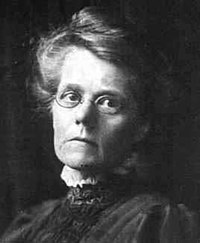Alicia Boole
| Alicia Boole Stott | |
|---|---|
 |
|
| Born | June 8, 1860 Cork, Ireland |
| Died |
December 17, 1940 (aged 80) England |
| Nationality | British |
| Known for | Mathematics |
Alicia Boole Stott (June 8, 1860 – December 17, 1940) was an Irish-English mathematician. Despite never holding an academic position, she made a number of valuable contributions to the field, receiving an honorary doctorate from University of Groningen . She is best known for coining the term "polytope" for a convex solid in four (or more) dimensions, and having an impressive grasp of four-dimensional geometry from a very early age.
Alicia Boole was born in Cork, Ireland, the third daughter of mathematician and logician George Boole and Mary Everest Boole, a self-taught mathematician and educationalist. Many of her sisters were notable in their own right. Lucy Everest Boole was a chemist and pharmacist and Ethel Lilian Voynich was a novelist. After her father's sudden death in 1864, the family moved to London, where her mother became the librarian at Queen's College, London. She attended the school attached to Queens' College with her sister, but never attended university.
Alicia was the only Boole sister to inherit her father's mathematical talent, although her mother Mary Everest Boole had brought up all of her five children from an early age 'to acquaint them with the flow of geometry' by projecting shapes onto paper, hanging pendulums etc. She was first exposed to geometric models by her brother-in-law Charles Howard Hinton when she was just 18, and developed the ability to visualise in a fourth dimension. She found that there were exactly six regular polytopes in four dimensions and that they are bounded by 5, 16 or 600 tetrahedra, 8 cubes, 24 octahedra or 120 dodecahedra. (Though this was already known to Schläfli) She then produced three-dimensional central cross-sections of all the six regular polytopes by purely Euclidean constructions and synthetic methods for the simple reason that she had never learned any analytic geometry. She made cardboard models of all these sections. She coined the term 'polytopes' to describe them.
...
Wikipedia
